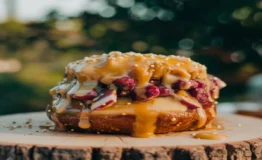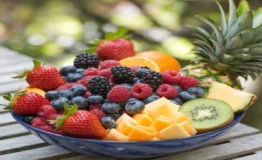What is Crème Brûlée Made Of?
Crème brûlée is a luxurious French dessert that has captured the hearts of food lovers worldwide. With its rich, creamy custard base and crispy, caramelized sugar topping, this iconic dessert is a favorite in fine dining establishments, as well as in home kitchens. But what exactly is crème brûlée made of, and how can you make it yourself? This article will guide you through the key ingredients, the process of making this crème, and some expert tips to perfect this decadent treat.
The Origins of Crème Brûlée
Before diving into the ingredients, it’s worth exploring a bit of history. Crème brûlée is a French term that translates to “burnt cream,” which refers to the caramelized sugar layer that tops this famous dessert. While crème brûlée is most commonly associated with France, its origins are debated. Some culinary historians believe that the dish was first made in 17th-century England, where it was known as “Trinity Cream” or “Cambridge Burnt Cream.” The dessert was served with a caramelized sugar crust at Trinity College, Cambridge. Meanwhile, others credit Catalonia, Spain, for the creation of a similar dessert called “crema catalana.”
Despite these claims, it is France that popularized the dessert as we know it today. In the early 20th century, crème brûlée became a staple in French cuisine, and its reputation quickly spread around the world. Today, it remains one of the most beloved desserts in the world, symbolizing both elegance and simplicity.
Key Ingredients of Crème Brûlée
The beauty of this crème lies in its simplicity. With just a handful of ingredients, you can create a dessert that is both indulgent and refined. Here are the essential components of this classic dish:
1. Egg Yolks
Egg yolks are the foundation of the custard base. They provide the rich, creamy texture that makes crème brûlée so irresistible. The yolks are beaten with sugar to create a smooth mixture that is later combined with cream. The key to achieving the perfect custard is balancing the richness of the egg yolks with the other ingredients.
When selecting eggs for this crème, opt for fresh, high-quality eggs. The better the eggs, the richer the custard will be. Using only the yolks, and not the whites, ensures that the custard remains smooth and velvety, rather than becoming too firm.
2. Heavy Cream
The heavy cream is what gives crème brûlée its luxurious texture. Cream is combined with egg yolks and sugar to form the custard, and the fat content of the cream ensures that the dessert is rich and satisfying. It’s important to use heavy cream with a high-fat content, as this will contribute to the dessert’s creaminess.
Some recipes may suggest substituting part of the cream with milk to lighten the dessert, but traditional crème brûlée is made exclusively with heavy cream for a reason. The richness of the cream is essential to creating that signature custard texture that melts in your mouth.
3. Sugar
Sugar is a crucial component of crème brûlée, playing two important roles in the recipe. First, sugar is used in the custard mixture to add sweetness. Typically, granulated white sugar is whisked with the egg yolks to create a smooth base for the dessert.
Second, sugar is responsible for the iconic caramelized topping. After the custard has been baked and chilled, a thin layer of sugar is sprinkled on top and then caramelized using a kitchen torch or broiler. This creates a crispy, crackling crust that contrasts beautifully with the smooth custard beneath it. Some chefs prefer to use a mixture of white and brown sugar for the topping, as the brown sugar adds a deeper flavor and color to the caramelization.
4. Vanilla
The vanilla in crème brûlée is what elevates the flavor of the custard. Traditionally, vanilla beans are used, as they provide the most authentic and intense vanilla flavor. The beans are split open, and the seeds are scraped into the cream, infusing the custard with the aromatic essence of vanilla.
If vanilla beans are not available, high-quality vanilla extract can be used as a substitute. However, it’s important to use pure vanilla extract rather than imitation vanilla, as the latter lacks the depth and complexity needed for this delicate dessert.
Optional Ingredients and Flavor Enhancements
While the classic crème brûlée recipe sticks to the basics, there are several optional ingredients and variations that can enhance the flavor and texture of the dessert. Some popular additions include:
- Orange or lemon zest: For a citrusy twist, you can add the zest of an orange or lemon to the custard mixture.
- Liqueurs: A splash of liqueur, such as Grand Marnier, Amaretto, or Bailey’s, can add depth and richness to the custard.
- Spices: Cinnamon, nutmeg, or cardamom can be added to the custard for a warm, spiced flavor.
How to Make Crème Brûlée: A Step-by-Step Guide
Making crème brûlée at home may seem intimidating, but with the right techniques and attention to detail, you can achieve restaurant-quality results. Here’s a step-by-step guide to creating the perfect crème brûlée:
Step 1: Preparing the Custard
Begin by whisking the egg yolks and sugar together in a mixing bowl until the mixture is smooth and pale yellow. This step is crucial for creating a smooth custard. Next, heat the heavy cream in a saucepan over medium heat until it is just about to boil. If you’re using vanilla beans, split the beans open, scrape the seeds into the cream, and add the pods as well. Let the cream steep for a few minutes to infuse the vanilla flavor.
Once the cream is hot, remove it from the heat. Gradually pour the hot cream into the egg yolk mixture while whisking continuously. This process is called tempering, and it prevents the eggs from curdling. Pouring the hot cream too quickly can result in scrambled eggs, so it’s important to add it slowly.
Step 2: Baking the Custard
After the custard mixture is prepared, it’s time to bake it. Preheat your oven to 325°F (160°C). Pour the custard into individual ramekins, filling each about three-quarters full. Place the ramekins in a large baking dish, and fill the dish with hot water until it reaches halfway up the sides of the ramekins. This water bath ensures that the custard cooks evenly and gently, preventing it from curdling or cracking.
Carefully transfer the baking dish to the oven and bake for about 40 to 45 minutes, or until the custard is set but still slightly jiggly in the center. The custard will continue to set as it cools, so it’s important not to overbake it.
Step 3: Cooling and Chilling the Custard
Once the custards are baked, remove them from the water bath and let them cool to room temperature. After they have cooled, cover the ramekins with plastic wrap and refrigerate for at least 2 hours, or overnight. Chilling the custard allows it to fully set and enhances the creamy texture.
Step 4: Caramelizing the Sugar Topping
The final step in making crème brûlée is creating the signature caramelized sugar topping. Just before serving, sprinkle an even layer of sugar over the top of each custard. For the best results, use superfine sugar, as it melts more evenly and creates a smoother caramel layer.
To caramelize the sugar, use a kitchen torch to melt and brown the sugar. Hold the torch about 2 to 3 inches above the sugar and move it in a circular motion until the sugar melts and turns golden brown. If you don’t have a torch, you can place the ramekins under your oven’s broiler for a few minutes, but be sure to watch them closely to avoid burning the sugar.
Once the sugar has been caramelized, let it cool for a minute or two to harden. The result should be a crispy, crackling top that contrasts beautifully with the smooth custard underneath.
Expert Tips for Perfect Crème Brûlée
Making crème brûlée can be a rewarding experience, but there are a few key tips that can help you achieve the best results:
- Tempering the Egg Yolks: As mentioned earlier, tempering is crucial for avoiding scrambled eggs in your custard. Be patient and pour the hot cream into the egg mixture slowly, whisking continuously.
- Achieving the Right Texture: The key to a perfect crème brûlée is baking it just long enough for the custard to set while still maintaining a slight jiggle in the center. Overbaking can result in a dense, rubbery texture, so it’s better to err on the side of caution.
- Caramelizing the Sugar: When using a torch, keep the flame moving in small circles to ensure even caramelization. If you stay in one spot for too long, the sugar can burn and develop a bitter flavor.
- Making Ahead: Crème brûlée is a great dessert to make in advance. You can prepare the custard a day or two ahead of time and store it in the refrigerator. Just before serving, caramelize the sugar topping for a freshly made appearance and texture.
- Serving Temperature: While crème brûlée is often served cold, some prefer it slightly warm. If you like your crème brûlée warm, let it sit at room temperature for a few minutes after caramelizing the sugar before serving.
Popular Variations of Crème Brûlée
While traditional crème brûlée is delicious on its own, there are many ways to put your own spin on this classic dessert. Here are a few popular variations:
1. Chocolate Crème Brûlée
For chocolate lovers, this variation adds a rich, cocoa flavor to the custard. Simply melt dark chocolate into the cream before combining it with the egg yolk mixture. The result is a dessert that combines the smoothness of custard with the indulgence of chocolate.
2. Citrus Crème Brûlée
Add a burst of freshness to your crème brûlée by infusing the cream with citrus zest. Orange, lemon, or lime zest can be added to the cream as it heats, giving the custard a bright, tangy flavor that pairs beautifully with the rich custard.
3. Lavender Crème Brûlée
Lavender adds a floral note to crème brûlée, making it a perfect choice for spring and summer gatherings. To make this variation, add dried lavender to the cream as it heats, then strain the cream before combining it with the egg yolk mixture. The lavender flavor is subtle but adds a unique twist to the classic dessert.
4. Vegan Crème Brûlée
For those who follow a plant-based diet, it’s possible to make a vegan version of crème brûlée. Substitute the egg yolks with a plant-based alternative, such as silken tofu or aquafaba, and use coconut cream instead of heavy cream. The result is a creamy, rich dessert that’s completely dairy-free and egg-free.
5. Gluten-Free Crème Brûlée
Crème brûlée is naturally gluten-free, making it an excellent choice for those with gluten sensitivities. Just be sure to use gluten-free vanilla extract and check that any additional flavorings or toppings are also gluten-free.
Frequently Asked Questions (FAQs)
Crème brûlée is a popular dessert, but it can also raise some questions for those making it for the first time. Here are answers to some of the most frequently asked questions about this crème :
What is crème brûlée made of?
Crème brûlée is made of a few simple ingredients: egg yolks, heavy cream, sugar, and vanilla. These ingredients come together to create a rich custard with a caramelized sugar topping.
Can I make this crème without a torch?
Yes, you can use your oven’s broiler to caramelize the sugar. Simply place the ramekins under the broiler and watch closely to ensure that the sugar melts evenly and doesn’t burn.
Can crème brûlée be made in advance?
Absolutely! You can make the custard portion of crème brûlée a day or two in advance and store it in the refrigerator. Just cover the ramekins with plastic wrap to keep the custard fresh. When you’re ready to serve, caramelize the sugar topping for a freshly made appearance.
What is the best sugar for caramelizing the top of crème brûlée?
A combination of white and brown sugar works well for caramelizing the top of crème brûlée. The white sugar creates a smooth, even caramel layer, while the brown sugar adds a deeper flavor and color.
Why is my crème brûlée not setting properly?
If your crème brûlée isn’t setting, it may not have been baked long enough. Make sure to bake the custard until the center is just slightly jiggly, then allow it to set as it cools. Chilling the custard in the refrigerator for a few hours will also help it firm up.
Can I use milk instead of cream in crème brûlée?
While you can substitute milk for cream, it will result in a lighter, less rich custard. For the best results, stick with heavy cream, as it provides the creamy texture that crème brûlée is known for.
Final Thoughts
this créme is a dessert that impresses with both its flavor and its presentation. While it may seem complex, it’s actually quite simple to make with the right ingredients and techniques. Whether you stick to the classic recipe or experiment with new flavors and variations, crème brûlée is a dessert that is sure to delight any crowd.
By mastering the basics of crème brûlée and adding your own creative twists, you can create a dessert that’s as impressive as it is delicious. Whether you’re serving it at a dinner party or enjoying it as a special treat, crème brûlée is a timeless dessert that will never go out of style.






